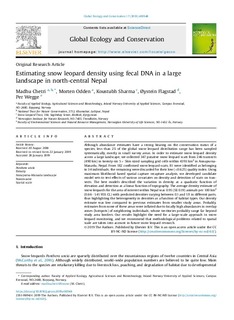| dc.contributor.author | Chetri, Madhu | |
| dc.contributor.author | Odden, Morten | |
| dc.contributor.author | Sharma, Koustubh | |
| dc.contributor.author | Flagstad, Øystein | |
| dc.contributor.author | Wegge, Per | |
| dc.date.accessioned | 2019-09-04T10:03:10Z | |
| dc.date.available | 2019-09-04T10:03:10Z | |
| dc.date.created | 2019-02-02T12:54:20Z | |
| dc.date.issued | 2019 | |
| dc.identifier.citation | Global Ecology and Conservation. 2019, 17 1-8. | nb_NO |
| dc.identifier.issn | 2351-9894 | |
| dc.identifier.uri | http://hdl.handle.net/11250/2612429 | |
| dc.description.abstract | Although abundance estimates have a strong bearing on the conservation status of a species, less than 2% of the global snow leopard distribution range has been sampled systematically, mostly in small survey areas. In order to estimate snow leopard density across a large landscape, we collected 347 putative snow leopard scats from 246 transects (490 km) in twenty-six 5 × 5km sized sampling grid cells within 4393 km2 in Annapurna-Manaslu, Nepal. From 182 confirmed snow leopard scats, 81 were identified as belonging to 34 individuals; the remaining were discarded for their low (<0.625) quality index. Using maximum likelihood based spatial capture recapture analysis, we developed candidate model sets to test effects of various covariates on density and detection of scats on transects. The best models described the variation in density as a quadratic function of elevation and detection as a linear function of topography. The average density estimate of snow leopards for the area of interest within Nepal was 0.95 (SE 0.19) animals per 100 km2 (0.66–1.41 95% CL) with predicted densities varying between 0.1 and 1.9 in different parts, thus highlighting the heterogeneity in densities as a function of habitat types. Our density estimate was low compared to previous estimates from smaller study areas. Probably, estimates from some of these areas were inflated due to locally high abundances in overlap zones (hotspots) of neighboring individuals, whose territories probably range far beyond study area borders. Our results highlight the need for a large-scale approach in snow leopard monitoring, and we recommend that methodological problems related to spatial scale are taken into account in future snow leopard research. | nb_NO |
| dc.language.iso | eng | nb_NO |
| dc.rights | Attribution-NonCommercial-NoDerivatives 4.0 Internasjonal | * |
| dc.rights.uri | http://creativecommons.org/licenses/by-nc-nd/4.0/deed.no | * |
| dc.title | Estimating snow leopard density using fecal DNA in a large landscape in north-central Nepal | nb_NO |
| dc.type | Journal article | nb_NO |
| dc.type | Peer reviewed | nb_NO |
| dc.description.version | publishedVersion | nb_NO |
| dc.source.pagenumber | 1-8 | nb_NO |
| dc.source.volume | 17 | nb_NO |
| dc.source.journal | Global Ecology and Conservation | nb_NO |
| dc.identifier.doi | 10.1016/j.gecco.2019.e00548 | |
| dc.identifier.cristin | 1672584 | |
| cristin.unitcode | 192,14,0,0 | |
| cristin.unitname | Miljøvitenskap og naturforvaltning | |
| cristin.ispublished | true | |
| cristin.fulltext | original | |
| cristin.qualitycode | 1 | |

